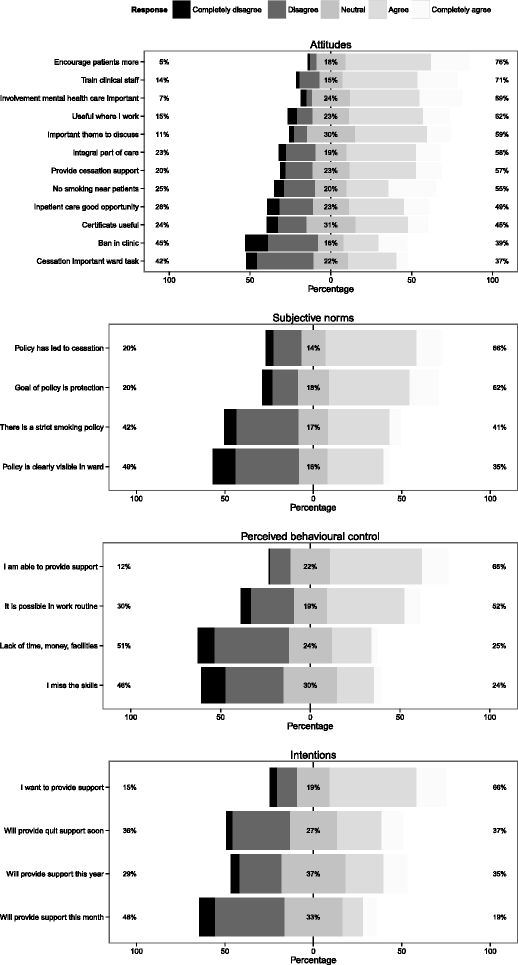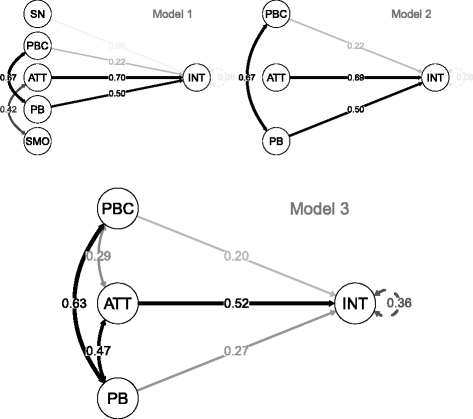Modelling intentions to provide smoking cessation support among mental health professionals in the Netherlands
- PMID: 27570503
- PMCID: PMC5000432
- DOI: 10.1186/s12971-016-0096-5
Modelling intentions to provide smoking cessation support among mental health professionals in the Netherlands
Abstract
Background: Tobacco use prevalence is elevated among people with mental illnesses, leading to elevated rates of premature smoking-related mortality. Opportunities to encourage smoking cessation among them are currently underused by mental health professionals. In this paper, we aim to explore mechanisms to invigorate professionals' intentions to help patients stop smoking.
Methods: Data stem from a recent staff survey on the provision of smoking cessation support to patients with mental illnesses in the Netherlands. Items and underlying constructs were based on the theory of planned behaviour and literature on habitual behaviour. Data were weighted and only data from staff members with regular patient contact (n = 506) were included. Descriptive statistics of the survey items are presented and in a second step using structural equation modelling (SEM), we regressed the latent variables attitudes, subjective norms (SN), perceived behavioural control (PBC), past cessation support behaviour (PB) and current smoking behaviour on intentions to provide support. In optimisation steps, models comprising a subset of this initial model were evaluated.
Results: A sample of 506 mental health workers who had direct contact with patients completed the survey. The majority of them were females (70.0 %), respondents had an average age of 42.5 years (SD = 12.0). Seventy-five percent had at least a BSc educational background. Of the respondents, 76 % indicated that patients should be encouraged more to quit smoking. Respondents were supportive to train their direct colleagues to provide cessation support more often (71 %) and also supported the involvement of mental health care facilities in providing cessation support to patients (69 %). The majority of the respondents feels capable to provide cessation support (66 %). Two thirds of the respondents wants to provide support, however only a minority (35 %) intends to actually do so during the coming year. Next, using SEM an acceptable fit was found of the constructs derived from the theory of planned behaviour and literature on habitual behaviour to the weighted data (χ (2) (322) = 1188, p < .001; RMSEA = 0.067; CFI = 0.983), after removal of insignificant latent variables (SN and current smoking) and inclusion of covariates. Attitudes, PBC and PB of staff are the strongest identified correlates of intention toward providing cessation support to patients. SN and staff smoking behaviour were found to be weaker, non-significant correlates.
Conclusions: To nudge staff towards providing cessation support to people with mental illnesses one should aim at influencing attitudes and perceived behavioural control.
Keywords: Psychiatry; Structural equation modelling; Survey research; Treatment and intervention.
Figures



Similar articles
-
Using an extended theory of planned behaviour to predict smoking cessation counsellors' intentions to offer smoking cessation support in the Taiwanese military: a cross-sectional study.BMJ Open. 2019 May 9;9(5):e026203. doi: 10.1136/bmjopen-2018-026203. BMJ Open. 2019. PMID: 31072854 Free PMC article.
-
Educational differences in the intention to stop smoking: explanations based on the Theory of Planned Behaviour.Eur J Public Health. 2004 Jun;14(2):194-8. doi: 10.1093/eurpub/14.2.194. Eur J Public Health. 2004. PMID: 15230509
-
Predicting Intention to Use Nicotine Replacement Therapy in People Attending Residential Treatment for Substance Dependence.J Dual Diagn. 2018 Apr-Jun;14(2):120-129. doi: 10.1080/15504263.2018.1442951. Epub 2019 Feb 17. J Dual Diagn. 2018. PMID: 29488836
-
[French validation of the Verona Service Satisfaction Scale-VSSS-54F].Encephale. 2003 Mar-Apr;29(2):110-8. Encephale. 2003. PMID: 14567162 French.
-
Theory of planned behavior and smoking: meta-analysis and SEM model.Subst Abuse Rehabil. 2010 Dec 6;1:23-33. doi: 10.2147/SAR.S15168. eCollection 2010. Subst Abuse Rehabil. 2010. PMID: 24474850 Free PMC article. Review.
Cited by
-
Using an extended theory of planned behaviour to predict smoking cessation counsellors' intentions to offer smoking cessation support in the Taiwanese military: a cross-sectional study.BMJ Open. 2019 May 9;9(5):e026203. doi: 10.1136/bmjopen-2018-026203. BMJ Open. 2019. PMID: 31072854 Free PMC article.
References
-
- Callaghan RC, Veldhuizen S, Jeysingh T, Orlan C, Graham C, Kakouris G, Remington G, Gatley J. Patterns of tobacco-related mortality among individuals diagnosed with schizophrenia, bipolar disorder, or depression. J Psychiatr Res. 2014;48(1):102–110. doi: 10.1016/j.jpsychires.2013.09.014. - DOI - PubMed
-
- World Health Organisation . WHO Report on the Global Tobacco Epidemic, 2015. Geneva: World Health Organisation; 2015.
LinkOut - more resources
Full Text Sources
Other Literature Sources
Miscellaneous

